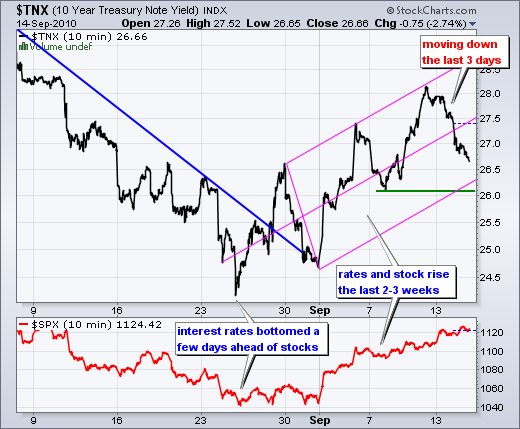There were a couple of bullish developments in the intermarket area over the last few weeks. First, bonds have been moving down and interest rates higher since late August. Bonds have been negatively correlated with stocks in 2010. Interest rates have been positively correlated. Despite an overall uptrend in rates, the 10-Year Treasury Yield ($TNX) has been moving lower the last few days. The chart below shows $TNX moving from 2.81% to 2.66% since Friday. Nevertheless, the overall uptrend in rates remains with support around 2.6%. A break below this level would be bullish for bonds and bearish for stocks.


The Euro ETF (FXE) surged over the last two days and broke above 128.5 resistance with a strong move. This is a vote of confidence for the risk-on trade. The Euro is no doubt moving higher in response to the Basel III agreement. As the chart below shows, FXE broke neckline resistance of an inverse head-and-shoulders and the upside target is around 131. Broken resistance turns into support around 128-128.5 for the first area to watch for a failure. A move back below 128 would be negative for stocks.
There is not much change on the daily chart, SPY surged to resistance with a gap up on Monday and then stalled. A doji formed on Monday and a spinning top on Tuesday. Stocks did not move higher after positive retail sales numbers. This could be a sign of bullish fatigue. So far Monday's gap is holding though. Filling this gap is the first step to a reversal. These candlesticks signal indecision that can sometimes foreshadow a reversal. The indicator windows show the Commodity Channel Index (CCI) in overbought territory (>100) and 1-day Average True Range (ATR) dipping below 1 on Friday. This indicator shows that Friday's range was the lowest since the second week of April. The red dotted lines show when CCI is overbought and ATR moves below 1. This combination foreshadowed tops in mid June and early August.

There is no change on the 60-minute chart, SPY has now gapped up four times in September. That's four of the last nine days. There sure is a lot of buying interest on the open. Except for the first gap (1-Sept), there has not been much follow through after the gap. Nevertheless, the ETF remains in a clear uptrend as the gaps hold. I am keeping short-term support to 110.5 to allow a little wiggle room. Broken resistance, Thursday's gap and Thursday's low combine to mark a support zone around 110.5-111. RSI remains in bull mode and has yet to even test its support zone around 40-50.

Key Economic Reports:
Wed - Sep 15 - 08:30 - NY Empire Manufacturing Survey
Wed - Sep 15 - 09:15 - Industrial Production
Wed - Sep 15 - 10:30 - Oil Inventories
Thu - Sep 16 - 08:30 - Jobless Claims
Thu - Sep 16 - 08:30 - PPI
Thu - Sep 16 - 10:00 - Philadelphia Fed
Thu - Sep 16 - 16:30 - Fed Balance Sheet
Fri - Sep 17 - 08:30 - CPI
Fri - Sep 17 - 09:55 - Michigan Sentiment
Charts of Interest: Tuesday and Thursday
This commentary and charts-of-interest are designed to stimulate thinking. This analysis is not a recommendation to buy, sell, hold or sell short any security (stock ETF or otherwise). We all need to think for ourselves when it comes to trading our own accounts. First, it is the only way to really learn. Second, we are the only ones responsible for our decisions. Think of these charts as food for further analysis. Before making a trade, it is important to have a plan. Plan the trade and trade the plan. Among other things, this includes setting a trigger level, a target area and a stop-loss level. It is also important to plan for three possible price movements: advance, decline or sideways. Have a plan for all three scenarios BEFORE making the trade. Consider possible holding times. And finally, look at overall market conditions and sector/industry performance.

About the author:
Arthur Hill, CMT, is the Chief Technical Strategist at TrendInvestorPro.com. Focusing predominantly on US equities and ETFs, his systematic approach of identifying trend, finding signals within the trend, and setting key price levels has made him an esteemed market technician. Arthur has written articles for numerous financial publications including Barrons and Stocks & Commodities Magazine. In addition to his Chartered Market Technician (CMT) designation, he holds an MBA from the Cass Business School at City University in London.
Learn More
